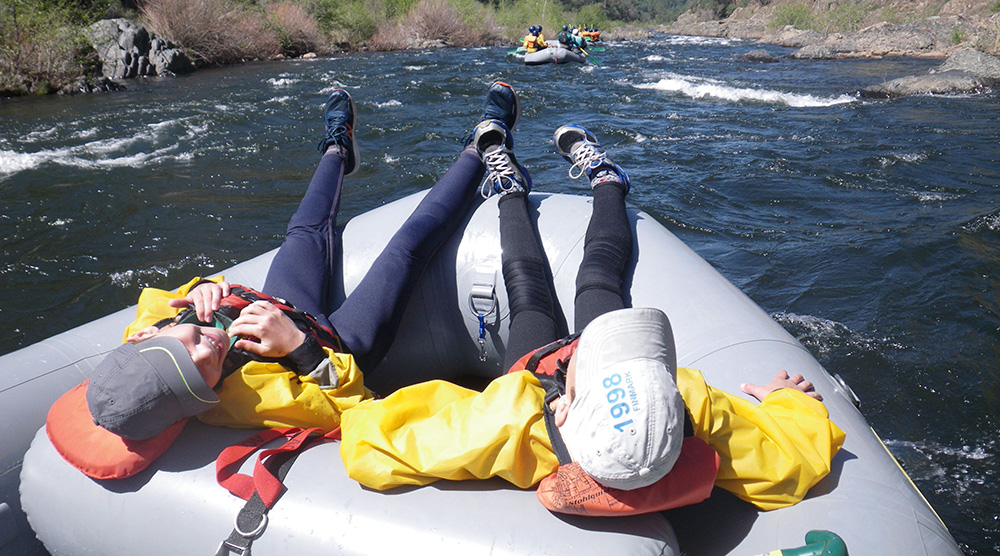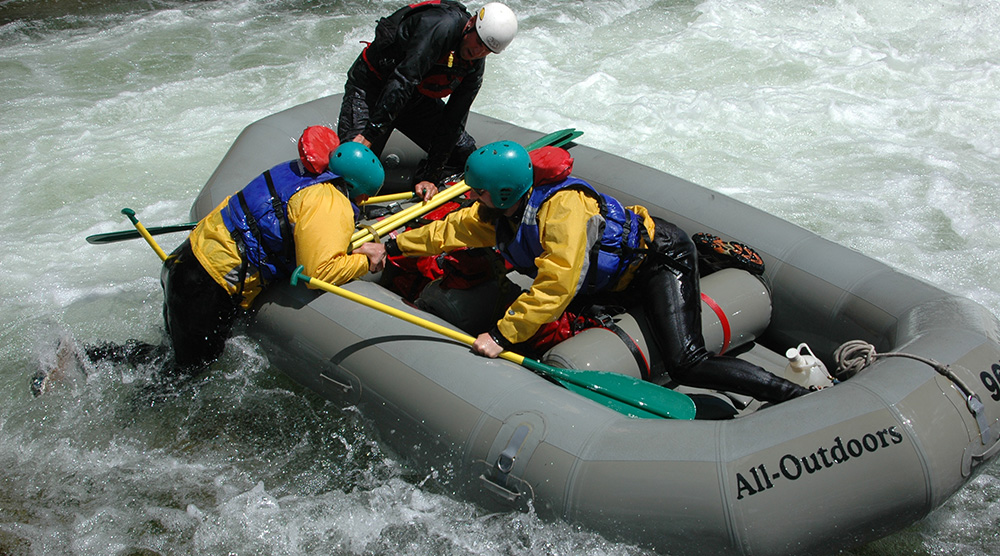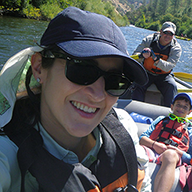Benefits of Wearing a Wetsuit for Rafting
Posted April 24, 2023 by Lenka Bostian
Whitewater rafting is one of the best ways to enjoy the natural beauty of a river canyon with the bonus of bursting through waves and getting splashed with refreshingly cool water. But it’s only fun when you are comfortable and not concerned about getting too cold. This is why wearing a wetsuit for rafting is something to embrace and not to be apprehensive about. If you like whitewater, you better understand how a wetsuit can be your BFF.
Benefits of a wetsuit
California rivers are famous for their chilly water. Unlike rain-fed rivers, the ones we raft on are fed by snow melting in the Sierra Nevada mountains. Whether you raft on fresh melt that was snow just yesterday, or water that is released from the bottom of a high-elevation reservoir, that water will feel very cold! When the air temperatures aren’t high enough to compensate for the frigid water, or when the splashiness or the river’s difficulty calls for it, you will want to wear a wetsuit for rafting. The extra layer of artificial blubber protects you not only from cold water but also keeps you warm on chilly or rainy days.
Having your legs padded with a wetsuit is an effective protection against bumps and scrapes should you find yourself in the river. The full coverage also works as a potential poison oak defense during scouting or portaging. One not-so-well-kept secret any triathlete will tell you is that wearing a wetsuit in the water adds buoyancy. So having one underneath your life jacket is a nice perk if you go for a swim in frothy whitewater. Plus, do we need to mention wetsuit makes for great sunscreen?

How does a wetsuit keep you warm?
Wetsuits are made out of neoprene which is a foam-like rubber material with thousands of tiny cells throughout. As indicated by its name, a WETsuit does not keep you dry. On the contrary – expect to get wet underneath the wetsuit! The important part is what happens next. The thick material traps a thin layer of river water next to your skin which then gets heated by your own body, keeping you nice and comfortable. So the first splash will feel cold and may make you gasp, but after that, you are good to go!
How should a white water rafting wetsuit fit? It should be form-fitting to your body, but not too tight to be restrictive. There are different styles and thicknesses of wetsuits that affect their insulating properties and pliability. The golden standard of a whitewater rafting wetsuit is 1/8“, or 3mm thick “farmer john” style (long legs but sleeveless), which provides a good combination of insulation and comfort. Thicker wetsuits may be warmer but could limit your range of motion for paddling, especially if they have long sleeves. Most rafters opt for the farmer john suit and combine it with a splash jacket to cover their arms.

When should you wear a wetsuit for rafting?
To an extent, wearing a wetsuit for rafting is a matter of personal preference. However, there are some guidelines and common practices. Those who get cold easily and people with less body mass, including kids, should always consider the wetsuit option unless the air temperatures are so high that overheating would be of greater concern. Cooler, overcast, and/or rainy weather universally calls for the use of a wetsuit, especially if the water you are rafting on is on the chilly side. In California, that means wetsuits (and splash jackets) are a staple for springtime rafting trips and a common sight in late fall. There is no reason to shy away from the river in early spring when you know What to Wear for Spring Rafting in California!
Another appropriate time to don a wetsuit is when your day on the river is expected to be extra splashy and there may be little time to dry off between rapids. Even on an otherwise warm and sunny day, you could get chilled from constant dousing with cold water. This is typically the case on rivers with a higher difficulty rating and in years with above-average snowpack when rivers are running at higher water flows longer into the summer. Lastly, whenever there is a potential of spending longer periods of time IN the water – whether on intentional leisurely swims or after unplanned “events,” you will find that wearing a wetsuit is a benefit.

Wetsuits on All-Outdoors rafting trips
We’ve been rafting for over 60 years and are familiar with the typical conditions on California rivers at different flows and times of the year. When you book a rafting trip with All-Outdoors, we’ll let you know in advance if wetsuits will be required on your trip, or if they MAY be required depending on the conditions on the day of your trip. These requirements are put in place for your comfort and safety, and to ensure maximum enjoyment of your time on the river. As an added service to our guests, we offer the use of wetsuits and splash jackets free of charge. See our Wetsuit, Splash Jacket Info and Additional Layering Tips for more information. If you have any questions about wetsuits or what to wear for rafting, don’t hesitate to contact us!
